
Parents usually want the best for their children, but when it comes to ski gear for the littlest skiers, there really isn’t much to differentiate one ski, boot or binding from another.
We’re all hard-wired to protect children. As near as I can tell, the “we” in the last sentence applies to all living things, but for the purposes of this pensée, let’s presume it at least applies to most mammals. When movie-makers want to rivet the audience’s attention, they put a toddler in peril. When we observe how non-human animals dote on their offspring, we feel the tug of affinity that suggests they’re just like us.
If the only evidence of a universal urge to protect one’s young were how humans treat their skiing progeny, this assumption of an omnipresent, instinctive protectiveness wouldn’t survive a minute’s cross-examination.
There are many reasons why little kids get the short end of the stick when it comes to ski gear. This isn’t an indictment, by the way; things are the way they are for many valid reasons, which we will immanently explore. Let’s take a look at junior gear, how it differs from what adults get, and what can be done to help the little tykes to ski better and have more fun.
Junior Skis
Nobody is making bank on the shortest skis on the wall. They’re all made virtually the same way, which is as inexpensively as possible. The cores will be injected foam and the bases extruded PE, which means the “finished” product won’t be close to flat. No one is going to spend money grinding bases and polishing edges on skis that are already unprofitable.
One reason your little darlings are in a perpetual snowplow is their bases are so railed their skis have no chance of turning any other way. If you want your kinder to demonstrate a higher skill set, tune their skis as you would your own.
Just about every ski 120cm or shorter is built on this elementary foundation, and to keep things simple, comes with its own binding. The binding, mercifully, is the least of your worries. Once one moves up to longer length models without a complementary binding, ski quality (and price) escalate markedly. The cores are usually wood and the overall construction is better than the first price-point lot.
Don’t worry about brand selection, worry about length. Saddling a defenseless urchin with a ski that is too long (e.g., over head height) isn’t a criminal offense, but it should be.
Junior Boots
Children cannot be sized or fit the same way as adults, period. Some allowance has to be made for growth, which may accelerate at any time. But while oversizing is baked into the process, just as with adults, going too far in this direction is dangerous. For starters, the child’s tiny foot will inevitably slide as far forward as it can, so they have to lean on the back of the boot just to stand up. Any hope of achieving a proper stance is DOA.
At worst, the child has no control at all. Junior boots are not anatomical because little kid’s feet aren’t any particular shape (yet). So, the shell isn’t anywhere near Junior’s jelly-like bag of bones called a foot. The larger the boot, the worse the problem. You couldn’t ski in a boot two sizes too big, and neither can your kids.
To allow for both grow room and the possibility of steering control, try these three checks on proper sizing. If it’s a new boot, pull the wafer-thin insole out of the liner and compare it to Junior’s foot; you’ll see exactly how much grow room you’ve got. Or pull the liner out of the shell (easy-peasy), and have Junior stand in the empty shell. (A bit barbaric, which is why I like the insole gambit better.)
Back to your child’s bare foot in the shell: have Junior slide his/her foot all the way forward and take a gander at the space behind the heel. If you can fit more than three fingers behind the Achilles, the boot’s too big.
As a final check on sizing, get the Little One all buckled in and have him/her walk for several paces. If he/she has no control over the front of the boot, so it always flops to the outside, the shell is too big.
Illuminating Parable Ripped from the Pages of History
As the last of five children, every piece of gear I saw before the age of 12 had seen better days. I was lucky if both skis had some base varnish and all their edges, and my boots were in the same indifferent state. In my formative years at Bromley, VT, I was left largely to my own devices, so I was without supervision when I summersaulted over my Northland ski tips and came out of – not just my skis, which continued on downhill, unperturbed – nor merely my boots, ditto, which soldiered on still attached to my skis – but clean out of my socks, which hadn’t been washed all season and were every bit as supportive as my hand-me-down leather boots.
I was left barefoot in the snow, halfway down The Lord’s Prayer. Henceforth scarred for life, I’m unnaturally fearful that children everywhere are currently suffering as I did. Actually, this might explain a lot.
Junior Bindings
Binding selection is cut and dried. The majority of kids’ skis come with their own bindings, so as long as Junior is in a children’s norm boot made for children’s bindings (with a max release setting of 4), everything is up to standard. Once Junior graduates to an adult norm sole, any junior binding (ISO scale 2-7), or adult binding that can be set to his/her ISO release value, is in play.
Put more simply, children’s norm boot soles won’t work with adult bindings, and visa versa. If you have any doubts about what works with what, visit your favorite specialty shop to sort it out. That’s why God created specialty ski shops, and His Humble Servant, The Pontiff of Powder, has created Jackson’s List to help you find them.
The next time you see some charming, wailing waif barreling straight down the bunny slope, it’s perhaps a sign of preternatural talent or an indication that the railed skis can’t be steered out of the fall line and tiny feet are pinballing around inside cavernous shells without the slightest effect on trajectory.
So, pity the poor children whom we handicap with untuned skis and unfit boots; their struggles aren’t (entirely) their fault. Their travails are just another way the sport we love toughens up its acolytes so they may endure a lifetime of its rewards.

